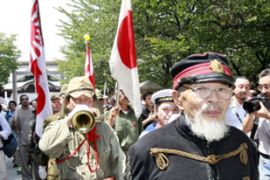Abe avoids Tokyo war shrine visit
Japan PM avoids stirring tensions on anniversary of World War II surrender.

Abe’s decision to stay away reflects the continued political sensitivities over Japan’s war time past, both inside Japan and neighbouring countries.
| Japanese veterans | ||
|
|
Most members of the Japanese cabinet are also expected not to visit the shrine.
Speaking at the ceremony attended by Emperor Akihito, Abe had expressed his remorse for the suffering caused by the Japanese military.
Abe said: “Japan caused great damages and pains to people in many countries, especially in Asia.”
“I express sympathy to the victims on behalf of the people of Japan.”
Akihito, after bowing before a floral memorial, vowed that Japan would never repeat the tragedy.
“I mourn those who perished in the war and pray for the world peace and Japan’s further progress,” he said.
Contested history
Abe came to office last September on a nationalist platform, arguing that it was natural for a head of state to pay homage to Japan’s war dead.
Although he has visited the Yasukuni shrine before, he has avoided doing so since taking office.
The shrine is located in central Tokyo and was established by Shinto priests in 1869 and was funded by the government until 1945.
It honours Japan’s war dead, including many convicted war criminals executed after World War II, such as Hideki Tojo, a wartime leader.
The shrine also holds a museum that depicts Japan’s wartime conquests as a crusade against Western colonialism in Asia.
